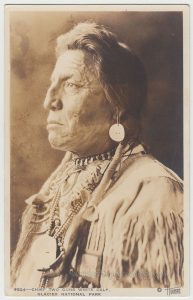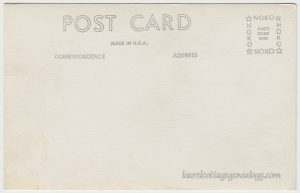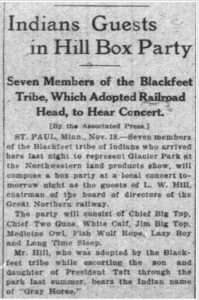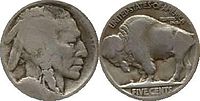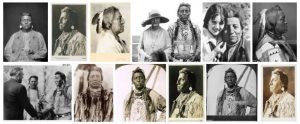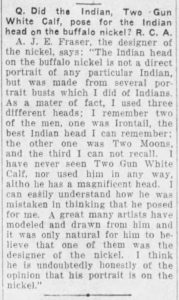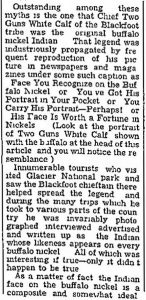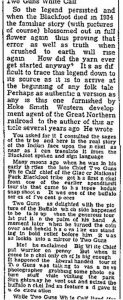Divided back, Real Photo Postcard, unused. Copyright Hileman. Photographer: Tomar Jacob Hileman. NOKO stamp box.
Price: $10.00
John Two Guns White Calf (1872 – 1934) was the son of White Calf; the father is said to have been the last of the Pikuni (a.k.a. Piikáni, Peigan, Piegan) Blackfoot chiefs and, as such, was involved in the sale of Blackfeet land that would become part of Montana’s Glacier National Park. Son, John “Two Guns,” and some of the other members of the park area Blackfoot tribe, became known as “the Glacier Park Indians” through their work for the Great Northern Railway via its campaign to promote the park (thus promoting the railway and its related business properties.) Through his travels and also his work as a greeter at the park, Two Guns White Calf became one of the most recognizable American Indians of his time; this was due in part to an advertising opportunity that had fallen into the lap of the railroad: the noted similarity between Two Guns and the Indian on the Buffalo nickel. It’s a great story, but not one that is based in fact, and that’s part of the fascination in both past and present: how the story came about and that the point of view is still propagating today.
Below, an early news clippings found in the Inter-Ocean (Chicago, Illinois) November 1912:
A skillfully orchestrated hoax
Pull up numerous historical newspaper articles on Two Guns and you can find phrases like “image is on” and “posed for” in relation to the coin, and true, Two Guns’ profile is remarkably similar to the image on the nickel……but absolutely not when looking at the shape of the nose. Two Guns’ nose was quite distinctive. (I’ve borrowed this word from someone and don’t remember quite where.) It juts downward at the bump (not the technical term, I know), as you can see in the postcard, even though his image there is not in perfect profile. Comparing his profile with that of the nickel image should lead anyone new to the topic to immediate skepticism and to dig in to further research, if needed. But, how did the story get started in the first place? See an explanation by journalist and author Ray Djuff, in an article that appeared in Coins Magazine, February 27, 2013: “The Big Nickel Lie; Two Guns’ Famed Mug Not Used,” and see the newspaper articles appearing further below, for a little additional background.
Production of the Buffalo nickel ran from 1913 – 1938.
Below, some images of Two Guns containing some better profile shots from a Google search:
A composite
The nickel’s sculptor, James Earle Fraser, also famous as the artist who sculpted “The End of the Trail,” clearly stated that the Indian on the nickel was not one man but a composite; naming Chief Iron Tail of the Ogalala Sioux and Chief Two Moons of the Northern Cheyenne, and a third and maybe fourth that he couldn’t remember. He also stated that Two Guns was not one of the models, nor had he ever met him, but it seems the statement about the unremembered other name or names is one reason the legend has lingered.
Below left, one of the quotes from Fraser, appearing December 1935 in Davenport, Iowa’s Quad-City Times. Below center and right, two excerpts from journalist Elmo Scott Watson, appearing in a March 1938 article in The Times-Independent (Moab, Utah). The clip on the right includes a quote from “…Hoke Smith Western development agent of the Great Northern Railroad…” (See the Ray Djuff link above on “Hoke” Smith).
Many roads to travel
The life of Two Guns would make for a great book (and one may already be in the works). In general, it’s difficult, if not impossible, to do justice to anyone really, in a (somewhat) short blog-type entry, but especially so in the case of Two Guns, because of his “association with” the Buffalo nickel, and because there is so much more to explore in context with the times: to name just a few topics, the Great Northern Railway history, publicity and the American Indian, see for instance, Two Guns’ mention in authors LaPier and Beck’s City Indian: Native American Activism in Chicago, 1893 – 1934, the history of the nickel itself, with the public reportedly clamoring to know the name of the Indian on the coin when it came out. (FYI, there was an original version of the coin, and then a “do-over” because portions of the design, specifically the “five cents,” was thought to be too indistinct; there’s the fact that not everyone loved the design of the buffalo, as some thought the animal had a forlorn, hang-dog kind of look, though if one took that view, it could be seen as historically fitting because of the buffalo’s slaughter in the wake of “progress;” and comically, in one newspaper journalist’s opinion, if you viewed the buffalo on an angle it looked like the face of a man.) Another aspect to explore in the life of Two Guns is his own stated belief that it was his visage on the coin. (He was not the only Indian claiming that it was their own likeness, of course, so there’s another major road, highway really, to explore.) But one wonders, not meaning to offend any of his descendants, if Two Guns really thought so, or if he might have privately viewed it as a “useful open-ended possibility” in any dealings he might have with the U.S. government in relation to the rights of the Blackfeet. That’s only my uneducated thought and one not necessarily adopted, and to be thorough, the history of the beliefs and ideology of the Blackfeet might also be explored. And because we’d like to know more about the man himself, to touch on the subject of family life, it was remarked in a newspaper article that he and his wife had a tender relationship when he cancelled an appearance at a New York reception to stay with her on a day that she didn’t feel well. By the way, a wonderful interview by Two Guns’ wife, who was described as “vivacious and loquacious,” can be read of her thoughts in 1913 on the modern women of New York. In answer to the reporter’s questions, she found New York women pretty, at the same time wondering at their restrictive clothing, fashion v. freedom and energy flow, noting how the “hobble skirt” that was currently in vogue, reminded her of how “when we want to keep our ponies from running off we hobble them,” and spoke in general, about the importance for women of having fresh air, un-restrictive clothing, work, and not necessarily marriage, but friendship.
Modern joys and pitfalls
The succession over the years of the many newspaper articles alone on Two Guns White Calf and the nickel is thought-provoking, not only in transporting us back to the past, seeing the similarities in reporting today v. then, getting a feel for how a myth evolved, but also in highlighting (once again) the wonder and pitfalls of the fast-paced world we now live in: Don’t happen to have a Buffalo nickel stashed away in a drawer? Online, and bingo, there it is, and you don’t even need a magnifying glass to get a good view. But the pitfall: with such instant information at our fingertips via the internet, it’s only natural that we’ve come to expect quick answers. I totally get this. Research is painstaking. I have boxes of photos, postcards, etc. waiting to go up on this website. (Rubbing hands together in anticipation.) Beauties, each a doorway into another dimension, and that feeling that there is never enough time. So, especially in Two Guns’ case, if one were doing a quickie post but sincerely wanting to check some sources like old newspaper articles, one could be forgiven (always, who’s perfect?) in posting misinformation or at the very least putting up a more limited view of a multi-level topic. It’s a great example of how a quickie look at something can lead us down the primrose path resulting in unknowingly becoming both victim and propagator in the “wrong info begets wrong info” trap. Even with pretty extensive research, there are dangers; for example, any archivist or genealogist will tell you that all sources need to be explored (though we can’t always know what “all” is) as it’s sometimes that one census record that one didn’t bother to hunt down, or that one whatever, that turns out to be a game-changer, as in: “Oh, a prior marriage….so such-and-such was not the maiden name,” or “OMG, this person was adopted.” But jumping down from this soapbox, my short-ish post on Two Guns is obviously not the biggest picture either, but rather just a part of a many-faceted likely as-yet-undiscovered whole.
In closing, we love the tongue-in-cheek expression, “Don’t let the facts get in the way of a good story” and variations thereof (He never lets the facts….) but in the case of John Two Guns White Calf, the truth makes a better story than the myth. We hope the book gets written.
Sources: Piegan Blackfeet. n.d. https://en.wikipedia.org/wiki/Piegan_Blackfeet (accessed December 11, 2017).
John Two Guns White Calf. May 21, 2012. nativeheritageproject.com. (accessed November 25, 20017).
“Did the Indian, Two Gun White Calf, pose for the Indian head on the buffalo nickel?” Quad-City Times (Davenport, Iowa). December 10, 1935. Tuesday, p. 12. (Newspapers.com).
Buffalo nickel. n.d. https://en.wikipedia.org/wiki/Buffalo_nickel (accessed November 25, 2017).
“Images of Two Guns White Calf.” Google.com. Accessed December 14, 2017.
“Indian Guests in Hill Box Party.” The Inter-Ocean. (Chicago, Illinois). November 19, 1912. Tuesday, p. 12.
James Earle Fraser (sculptor). n.d. https://en.wikipedia.org/wiki/James_Earle_Fraser_(sculptor). (accessed December 12, 2017).
Djuff, Ray. “The Big Nickel Lie; Two Guns’ Famed Mug Not Used.” February 27, 2013. Coins Magazine. (accessed at NumisMaster.com. November 25, 2017).
LaPier, Rosalyn R.Beck, David R. M. City Indian: Native American Activism in Chicago, 1893 – 1934. University of Nebraska Press. May 31, 2015.
“Buffalo Nickel Now Creating A Lot Of Trouble.” The Lima Daily News (Lima, Ohio). January 26, 1914. Monday, p. 4. (Newspapers.com).
“The New Five-Cent Piece. Indian and Buffalo Design Defended by an Admirer.” The New York Times. March 5, 1913. Wednesday, p. 16. (Newspapers.com)
Marshall, Marguerite Mooers. ” ‘New York Women Heap Nice to Look At,’ Mrs. Two Guns White Calf Explains.” The Arkansas Gazette. (Little Rock, Arkansas). March 31, 1913. Monday, p. 7. (Newspapers.com)

